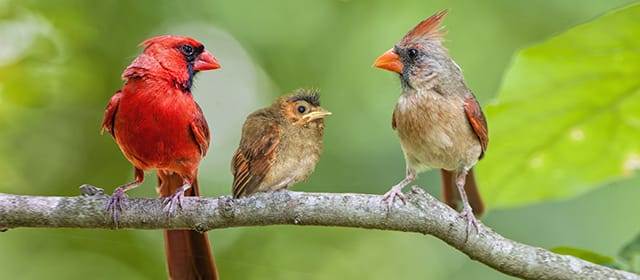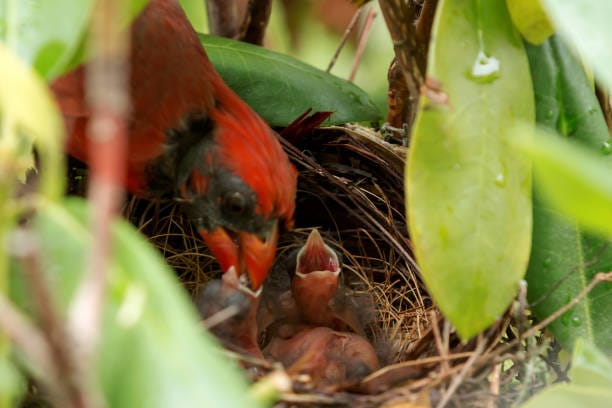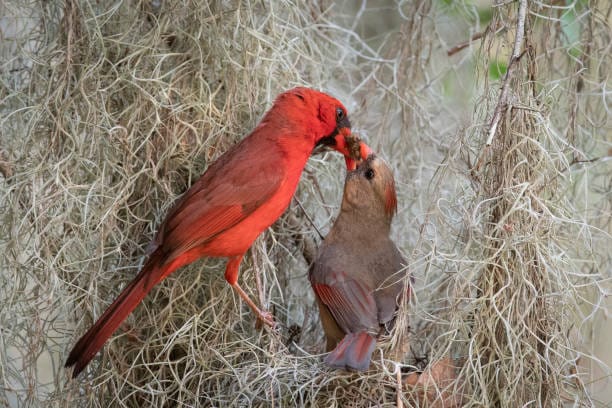Here’s everything you need to know about Baby Cardinals…
What does a baby cardinal look like?
At birth
When baby cardinals hatch, they are completely naked, with closed eyes and underdeveloped wings. They are also quite helpless and rely completely on their parents for food and warmth.

Growth and development
Over time, baby cardinals begin to grow feathers and develop more motor skills. As they grow, they become more active and curious, and eventually, they learn to fly.

How big are baby cardinals?
Baby cardinals are very small when they are born, weighing only a few grams. However, they grow quickly and can reach full size within a few weeks.
How much do baby cardinals weigh?
A baby cardinal typically weighs between 0.2 and 0.5 ounces at birth, depending on the size of the egg and the health of the parents.
Why do you never see baby cardinals?
Baby cardinals are often hidden away in their nests, which are usually located in dense bushes or trees. This makes it difficult to spot them, especially when they are very young.
What is a baby cardinal called?
A baby cardinal is called a hatchling or nestling, depending on its age.
What do baby cardinals eat?
Baby cardinals are fed a diet of insects, fruits, and seeds by their parents. As they grow, their diet becomes more varied and they begin to eat more seeds.
Do both parents feed baby cardinals?
Yes, both male and female cardinals take turns feeding their young.
How do cardinals feed their chicks?
Cardinals regurgitate food into their chicks’ mouths. This ensures that the food is soft and easy to swallow.
How many babies does a cardinal have?
Cardinals typically lay 3-4 eggs at a time, but they can lay up to 5 eggs in a single clutch. They may have 2-3 clutches per breeding season.
What do cardinal eggs look like?
Cardinal eggs are a pale blue-green color, with brown or gray speckles.
How long do cardinal eggs take to hatch?
Cardinal eggs take about 11-13 days to hatch, depending on the temperature and humidity in the nest.
When do cardinals lay eggs?
Cardinals typically breed from March to August, with the peak breeding season occurring in April and May.
How long do baby cardinals stay with their parents?
Baby cardinals stay with their parents for about 4-5 weeks after hatching, during which time they are taught how to fly and hunt for food.
Learn what a baby cardinal looks like, from egg to fledgling, with these photos.
Here are some photos of baby cardinals at different stages of development:
Cute Baby Cardinal
Cardinal Mom on Duty

Juvenile Cardinal

Ready to Fly

Fluffy Baby Cardinal Birds

Feeding Time With Dad

Feathered Friend

Sweet Moment With Mom

Cardinal Development Stages
What do Baby cardinals look like?
Baby cardinals go through several stages of development, each with its own distinct characteristics.
Hatchling Cardinals
When a baby cardinal first hatches, it is completely naked, with closed eyes and underdeveloped wings.
Nestling Cardinals
As a baby cardinal grows, it begins to develop feathers and gain more motor skills. It is still quite helpless, however, and relies completely on its parents for food and warmth.
Fledgling Cardinals
After a few weeks, a baby cardinal will leave the nest and become a fledgling. Fledglings are able to fly, but they are still learning how to hunt for food and fend for themselves.
How long do cardinal babies stay in the nest?
Baby cardinals stay in the nest for about 9-11 days after hatching, until they are able to fly.
What do baby cardinals look like when they leave the nest?
When a baby cardinal leaves the nest, it has a full set of feathers and is able to fly, but it is still smaller and less colorful than an adult cardinal.
Juvenile Cardinals
After leaving the nest, a baby cardinal becomes a juvenile. Juveniles are able to hunt for food on their own, but they still have some growing to do before they reach full size.
Male vs Female Juvenile Cardinals
Male and female juvenile cardinals look very similar, with brownish feathers and a distinctive crest on their head. It is difficult to tell them apart until they reach full maturity.
What Do Baby Cardinals Eat? Know the Facts
Baby cardinals are fed a diet of insects, fruits, and seeds by their parents. As they grow, their diet becomes more varied and they begin to eat more seeds.
Insects are particularly important for young cardinals, as they provide a rich source of protein and other nutrients that help the chicks grow quickly.
Identifying the Northern Cardinal
Coloration
The Northern Cardinal is a small, bright red bird with a distinctive crest on its head. The male has a red body with a black mask around its eyes, while the female is mostly brown with a red crest and tail.
Common Range
The Northern Cardinal is a common bird in the eastern United States, from Maine to Texas and as far west as Arizona and New Mexico.
Birdsong
Male Northern Cardinals are known for their beautiful, distinctive songs, which are often heard in suburban and urban areas. They sing throughout the year, but their songs are particularly loud and frequent during the breeding season.
Nesting
Northern Cardinals build their nests in dense bushes or trees, usually about 3-10 feet off the ground. The nest is made of twigs, leaves, and other plant materials, and is lined with grass, feathers, and other soft materials.
Laying and Incubating
Female Northern Cardinals lay 3-4 eggs at a time, which they incubate for about 11-13 days. During this time, the male brings food to the female and helps protect the nest from predators.
What Baby Cardinals Eat
Baby cardinals are fed a diet of insects, fruits, and seeds by their parents. As they grow, their diet becomes more varied and they begin to eat more seeds.
Fledging
After about 9-11 days, baby cardinals leave the nest and become fledglings. Fledglings are able to fly, but they are still learning how to hunt for food and fend for themselves.
Paternal Instincts
Both male and female Northern Cardinals play an important role in raising their young.
The male helps feed the female while she is incubating the eggs, and both parents take turns feeding and caring for the hatchlings.
Predators
Baby cardinals are vulnerable to a variety of predators, including cats, snakes, and birds of prey. Parents help protect their young by staying close to the nest and attacking any potential threats.
Popularity
The Northern Cardinal is a popular bird among birdwatchers and backyard bird enthusiasts. Its bright red coloration and beautiful songs make it a welcome sight and sound in many gardens and parks.
In conclusion, baby cardinals are fascinating creatures that go through several stages of development before they become fully grown birds.
They are cute and fluffy when they are born, and their parents take great care to feed and protect them until they are able to fend for themselves.
Learning about the life cycle of baby cardinals can help us appreciate the natural world around us and understand the importance of preserving their habitat.
Whether you are a bird lover, a nature enthusiast, or just someone who enjoys learning new things, there is no denying that baby cardinals are an interesting and unique topic.
By understanding what they look like, what they eat, and how they develop, you can gain a deeper appreciation for these beautiful birds and the role they play in our ecosystem.
So next time you spot a cardinal in your backyard or local park, take a closer look and see if you can identify any baby cardinals that might be hiding nearby.
Who knows, you might just catch a glimpse of one of these adorable creatures as it takes its first flight into the world.
Frequently Asked Questions about Baby Cardinals
What does it mean when you see a baby cardinal?
Seeing a baby cardinal can mean that there is a cardinal nest nearby. It’s important to give them space and not disturb the nest, as this can cause stress to the birds.
How long is a cardinal pregnant?
Cardinals, like all birds, do not get pregnant. They lay eggs which take about 12-13 days to hatch. Both the male and female take turns incubating the eggs.
How long do baby cardinals nest?
Baby cardinals typically stay in the nest for about 9-11 days after hatching. After leaving the nest, they may continue to be cared for by the parents for another 2-3 weeks.
What color are baby cardinals beaks?
Baby cardinals have dark gray or black beaks, which gradually turn orange as they mature. This change in color is usually complete by the time the birds leave the nest.
How long do baby cardinals nest?
Baby cardinals typically stay in the nest for about 9-11 days after hatching. After leaving the nest, they may continue to be cared for by the parents for another 2-3 weeks.
What Do Cardinal Eggs Look Like?

Cardinal eggs are grayish-white, buffy white or greenish-white speckled with pale gray to brown. The average size is about 1.4 inches long by 1 inch wide. There are usually three to four eggs in a clutch, although there may be as many as six. The eggs hatch in about two weeks.
When Are Baby Cardinals Born?

Baby cardinals are typically born between late April and early May. However, if the weather is particularly cold or if food is scarce, baby birds may not be born until later in the season.
The female cardinal will lay two to five eggs in a nest made of sticks, twigs, and leaves. She will incubate the eggs for about 12 days before they hatch.
What Does a Baby Cardinal Look Like?

Baby cardinals are born without any red plumage. It takes them a few weeks to grow into their adult plumage. When they are first born, they are mostly grayish-brown in color. Baby cardinals have a black beak and black legs. They also have a small tuft of red feathers on their head, which eventually grows into the adult cardinal’s crest.
As baby cardinals grow, they slowly start to develop their red plumage. By the time they are about four weeks old, they should have most of their red feathers. They reach full size at around six months old.
Cardinals are not born with their distinctive red crest. The crest starts to grow when the bird is about two weeks old. They also have a black beak and black legs.
What do Baby Cardinals Eat?

Baby cardinals eat mostly insects. They also eat some fruits and berries. They’re are fed by their parents, who bring them food to the nest. The parents will continue to feed the young birds until they are old enough to fend for themselves.
Typically leave the nest when they are about two weeks old. They will start to eat on their own, but they will still be fed by their parents for another week or two. After that, the young birds are on their own and must find food on their own.
How Long Do Baby Cardinals Stay With Their Parents?

They typically stay with their parents for about two months. During this time, the young birds learn how to find food and avoid predators. After they leave their parents, they’ll form flocks with other young birds. They will stay in these flocks until they are ready to mate and start their own families.
How Fast Do Baby Cardinals Grow?

Baby cardinals grow quickly! They typically double their weight in the first week of life. By the time they are two weeks old, they will have tripled their weight. Baby cardinals reach full size at around six months old.
When Do Baby Cardinals Turn Red?

Cardinals mature relatively slowly compared to other birds. It takes them approximately 18 months to reach full adult plumage. This means that they won’t turn red until they are around 18 months old.
However, this doesn’t mean that you won’t be able to see any red on them before they turn 18 months old. Juvenile cardinals typically start to develop their red plumage when they are about four weeks old. As they get older, more and more of their feathers will turn red until they eventually reach full adult plumage.
When do Baby Cardinals start To Sing?

Baby cardinals start to sing when they are about four weeks old. However, their songs are not as beautiful as the adult cardinal’s song. They’ll continue to practice and perfect their singing until they reach adulthood.
How Does It Learn to Fly?

They start to practice flying when they are about three weeks old. They will make short flights from the nest to nearby branches. By the time they are four weeks old, they should be able to fly well enough to keep up with their parents. They reach full flying ability at around six weeks old.
Do Mother Birds Sleep in the Nest With Their Babies?

No, the mother bird does not sleep in the nest with her babies. She will occasionally take a break from sitting on the eggs to eat or drink, but she will typically return to the nest within a few minutes.
Do Baby Birds Need to Be Fed at Night?

No, baby birds do not need to be fed at night. They will typically sleep through the night and will only be fed during the day.
Baby birds need to be fed every few hours, and they will usually eat between 5 and 8 times per day.
Do Baby Birds Drink Water?

Yes, baby birds need to drink water. They will typically drink water from their mother’s mouth or from a small cup that is placed in the nest.
